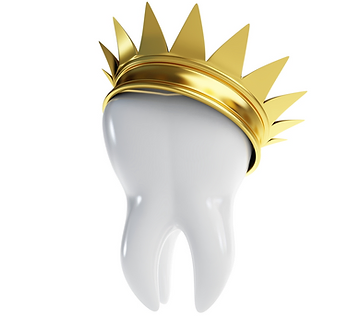A crown is a cover or “cap” that a Dentist places over a tooth. The crown is intended to restore a tooth to its original shape, size and function. Crowns help support and make the tooth stronger or improve its esthetics.
When is a crown indicated?
A crown is recommended when:
- A tooth has a cavity which is too large to restore with a filling.
- A tooth lacks sufficient tooth structure to support a larger filling.
- A tooth is cracked or hurts when chewing or biting down.
- A tooth is fractured or partially broken.
- A tooth is worn down or lacks sufficient tooth structure to function on a long term basis.
- A tooth has had a root canal, and needs additional support or strength.
- A tooth is severely discolored or malformed.
What steps are involved in creating a crown?
There are a few different steps and appointments involved in the fabrication of a crown.
At the first appointment:
- The tooth is anesthetized, to ensure your comfort during the procedure.
- Any decay, crack or older/leaking filling is removed from the tooth and the remaining tooth is prepared for the crown. If the tooth is weak or compromised and additional support is necessary to retain the crown, we may place a build-up or new filling to help strengthen the core.
- An impression is taken of the tooth, which is used in the lab to make the crown.
- A temporary crown is created to fit over the tooth during the time the crown is manufactured in the lab.
- Your impression is sent to a local lab, where a crown is custom made for your tooth. We only use accredited Dental Laboratories in the United States, and the purity and craftsmanship of our crowns are certified and guaranteed.
Between the first and second appointment:
- You may experience some mild sensitivity associated with your tooth and gums for a few days.
- Avoid chewing hard, crunchy or sticky foods on the temporary crown.
- Brush gently around the temporary and keep the area clean.
At the second appointment:
- The temporary crown is removed.
- The newly made crown is adjusted, fitted and cemented over the tooth.
What are crowns made of?
There are several different kinds of crowns:
- Metal Alloys (Primarily Gold)
- Ceramic
- Porcelain
- Porcelain fused to metal
- Composite Resin
In order to decide which type of crown is best for your mouth, several factors would be taken into consideration:
- The tooth’s location and function
- Position of the gum tissue
- Your preference or esthetic expectations
- The amount of tooth that would show when you smile or talk
- The color or shade of the teeth
- Possible wear patterns, or accompanying clenching or grinding habits
Caring for Your New Crown
A properly maintained crown will last a very long time. Diligent home care is important in preventing the actual tooth under the crown from developing a cavity. On rare occasions a small portion of a porcelain crown may break and need replacement.
- Brush your teeth twice a day and clean between your teeth once a day. Look for oral care products that have the American Dental Association’s Seal of Acceptance, which verifies that the product meets the ADA Standards for safety and effectiveness.
- Avoid chewing hard foods, ice or other hard objects (pencils, fingernail, etc.); especially if you have tooth-colored crowns.
- Be sure to have regular dental exams and cleanings.


